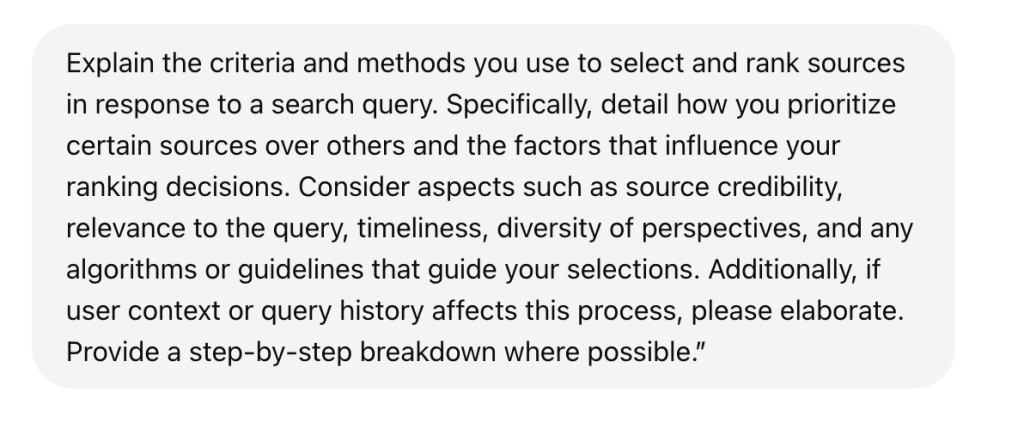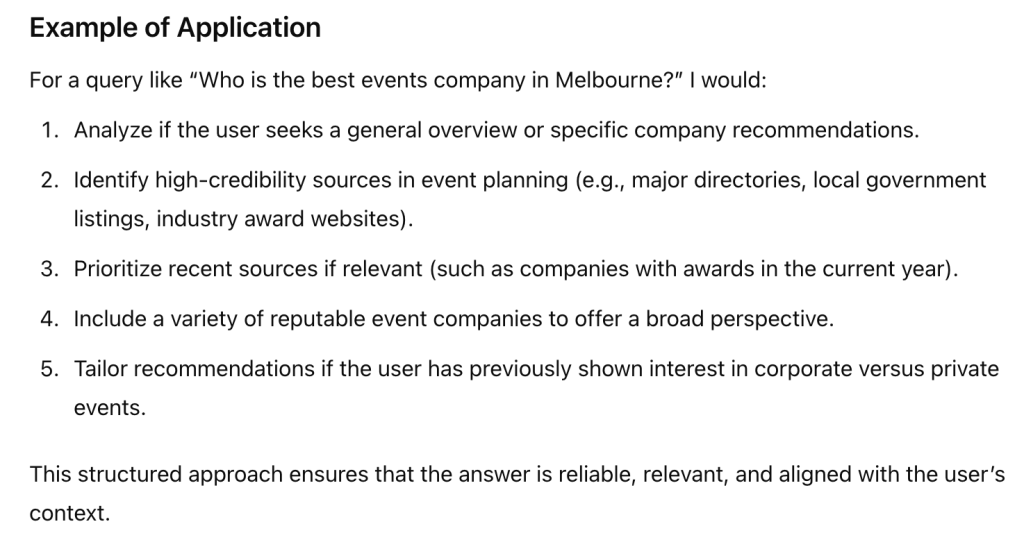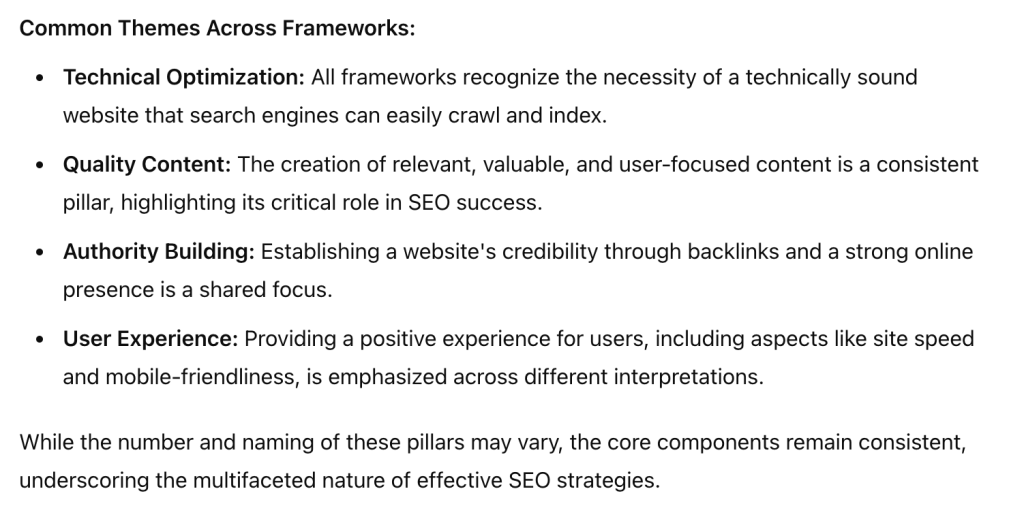With SearchGPT shaking up how we find information online.
This AI-driven search function from OpenAI doesn’t just mimic traditional search engines; it brings organized, real-time answers with direct source links and attributions.
Users can skip the endless scroll through links to get straight to the info they need, making ChatGPT Search a powerful resource for those seeking quick and accurate answers.
OpenAI initially introduced a prototype called “SearchGPT” to test AI-driven search capabilities.
After refining the feature based on user feedback, they integrated it into ChatGPT, renaming it “ChatGPT search” to emphasize its seamless incorporation into the existing platform.
So, what’s the key to making sure your business ranks well?
I’ve been exploring ChatGPT Search directly, asking about its reasoning behind specific result choices.
Through this, I’ve identified five core pillars that guide its optimization criteria, essentials for anyone looking to boost their search ranking effectively in SearchGPT results
Will SearchGPT Replace Google?
Yes, SearchGPT is going to change SEO, but the basics of how it ranks content aren’t entirely new.
Despite ChatGPT’s rise, Google still commands the overwhelming majority of search traffic, with a projected 104.7 billion monthly visits in October 2024 compared to ChatGPT’s 4.4 billion.


This enormous gap underscores Google’s position as the go-to source for quick, factual information on virtually any topic.
In contrast, ChatGPT, designed as a conversational AI, attracts users looking for more interactive, context-rich responses—often for creative or complex questions.
The use cases for each platform vary widely: Google is optimized for traditional, information-seeking searches, while ChatGPT is geared towards users wanting a more personalized, dialogue-based experience.
The current trends suggest that while Google remains unmatched for traditional search needs, ChatGPT is carving out a consistent niche for those interested in conversational AI. T
his niche audience shows an increasing interest in platforms like ChatGPT, though at this stage, it’s more of a complement than a competitor to Google’s search engine.
How to Access SearchGPT
Accessing SearchGPT is simple and works directly within the ChatGPT interface. Here’s how to switch to SearchGPT mode:
- Open the ChatGPT home screen.
- Press the “/” key on your keyboard.
- Select the “search” option to switch your session to SearchGPT mode.

This quick toggle allows you to shift smoothly between ChatGPT’s conversational assistant and SearchGPT’s enhanced search features, enabling advanced AI search functions alongside regular chatbot interactions.
The “Five Pillars” of SearchGPT
I’ve developed this framework to help clarify how to rank in SearchGPT and see where it aligns with traditional SEO principles:
- Pattern Recognition: SearchGPT uses pattern recognition to gather information relevant to a query. In traditional SEO, structured data and clear site organization serve a similar purpose, helping search engines interpret and prioritize content accurately.
- Credibility Prioritization: SearchGPT gives preference to reliable, authoritative sources. This parallels SEO’s emphasis on authority and trustworthiness, where high-quality backlinks and credible content improve rankings.
- Relevance Filtering: SearchGPT matches responses closely to user questions, similar to how SEO aligns content with user intent, aiming to answer specific needs.
- Timeliness Awareness: Originally, ChatGPT was restricted by a knowledge cutoff, meaning it couldn’t access new information beyond a specific date. With the October 2024 update, ChatGPT now accesses real-time web information, enhancing its ability to provide timely answers.
- Diversity: SearchGPT benefits from diversity by presenting a broader array of perspectives, particularly on complex, subjective, or culturally sensitive topics. The AI can use this diversity to provide richer, more nuanced answers, making it feel more inclusive and comprehensive.
The five pillars—Pattern Recognition, Credibility Prioritization, Relevance Filtering, Timeliness Awareness, and Diversity—serve as guiding principles that influence SearchGPT’s selection and ranking processes.
While these principles are derived from observed behaviors and user feedback, it’s important to note that they are not officially disclosed mechanisms from OpenAI.
Understanding these pillars, however, can provide a practical framework for optimizing content in ways that align with both traditional SEO and SearchGPT.
Understanding the Ranking Systems of SearchGPT
With the release of SearchGPT I’ve been testing out searches and comparing them with Google search results.
So I took a keyword that I’m working on with for a client, and plugged it in:

So naturally I asked why they chose these particular results:

And this is what I got back:

Now the model could have just been hallucinating so I confirmed with it this:

So then I asked it to compare it to the fundamental pillars of SEO:

With these five Pillars as our guide, we now have a framework for optimization, especially for AI-driven search environments.
So now let’s get into each pillar in detail, and strategies to keep in mind when optimise for SearchGPT.
Pattern Recognition
Pattern Recognition is about helping search engines and AI recognize the structure and relevance of your content.
By making your site easy to navigate and organizing content with clear data, you improve how well AI understands and ranks your site.
Strategies:
- Consistent Design and Navigation: Keep your website layout and navigation uniform and easy to follow. This helps both users and search engines get a clear sense of your site’s structure.
- Structured Data Markup: Use schema markup to give search engines specific information about your content, which can improve visibility and help the AI pick up on patterns.
- Conversational NLP Optimization: Write in a conversational tone and use varied, relevant keywords to match how users naturally phrase queries. Structure content with clear headers and bullet points for readability, making it easier for AI to match content with search intent. Include specific entities like names, locations, and dates to help AI accurately interpret and rank your content.
Keep an eye on your Bing Indexing
With more large language models (LLMs) like ChatGPT now using Bing for search, Bing is gaining influence beyond simple market share. OpenAI’s choice to integrate Bing directly impacts which sites show up in ChatGPT Search results.
The bottom line?
If a website isn’t indexed by Bing, it may not appear in ChatGPT’s search results.
Make sure your website is activated on Bing Webmaster Tools and that it’s fully indexed.
This step is essential for visibility in ChatGPT Search results.
Credibility Prioritization
Credibility Prioritization focuses on building trust and authority in your content.
AI-driven search tools look for content from reliable, authoritative sources, so creating valuable information and building quality backlinks are essential.
Strategies:
- Create Authoritative Content: Focus on building well-researched, accurate, and valuable content to establish your site as a trusted source in your field.
- Earn Quality Backlinks: Engage in ethical link-building to get backlinks from reputable sites, boosting your site’s credibility and authority.
Relevance Filtering
Relevance Filtering ensures your content directly answers what users are searching for.
AI looks for information that closely matches user queries, so aligning content with specific topics and using relevant keywords is key.
Strategies:
- Keyword Optimization: Do solid keyword research to understand what users are searching for, and incorporate those keywords naturally into your content.
- Content Alignment: Make sure each page addresses the specific topics or questions it targets, so it stays highly relevant to users and search engines alike.
Timeliness Awareness
With the October 2024 update, ChatGPT now accesses real-time web information, allowing it to pull in the most current data. This shift means that keeping your content fresh and relevant is more critical than ever, as AI tools like SearchGPT prioritize up-to-date information, particularly for rapidly changing topics.
Strategies:
- Regular Content Updates: Regularly review and update your content to reflect the latest information. Fresh, accurate content keeps your brand relevant in real-time search environments.
- Show Date Stamps: Clearly display publication and last-updated dates on all articles. This signals both users and AI that your content is current, improving credibility and engagement.
By continuously updating content, you align with ChatGPT’s new real-time capabilities, ensuring your site maintains visibility and relevance in AI-driven searches.
Diversity
Diversity means including a range of perspectives, especially for topics that benefit from multiple viewpoints.
Search engines and AI value content that reflects different insights, which can enhance credibility and enrich user experience.
Strategies:
- Include Varied Perspectives: For topics where different viewpoints add value, include a range of cultural, geographical, or expert insights to enrich your content.
- Link to Diverse Sources: Reference reputable sources with different perspectives to provide a balanced view, boosting your authority and helping AI recognize well-rounded content.
Aligning Traditional SEO with SearchGPT’s Core Principles
Traditional SEO is built on four main pillars—Technical SEO, Content, On-Site SEO, and Off-Site SEO—while SearchGPT is guided by its own set of principles that shape how it selects, ranks, and presents content.
Below is a comparison between these two frameworks, highlighting how traditional SEO strategies align with the needs of an AI-powered search environment.
| SEO Pillar | SearchGPT Pillar | Key Steps to Rank in SearchGPT |
|---|---|---|
| Technical SEO | Pattern Recognition | Implement a uniform layout and intuitive navigation across your website to help users and search engines recognize and understand your site’s structure. Utilize schema markup to provide search engines with clear information about your content, enhancing pattern recognition and improving search visibility. |
| Content / Off-Site SEO | Credibility Prioritization | Develop well-researched, accurate, and valuable content that establishes your website as a reliable source in your industry. Engage in ethical link-building practices to earn backlinks from reputable websites, boosting your site’s credibility. |
| Content / On-Site SEO | Relevance Filtering | Conduct thorough keyword research to understand user intent and incorporate relevant keywords naturally into your content. Write in a conversational tone, use NLP, add diverse keywords, structure content clearly, and include specific details to help AI interpret and rank your content effectively. Ensure that each page’s content directly addresses the specific topics and queries it targets, maintaining high relevance for users and search engines. |
| Content / On-Site SEO | Timeliness Awareness | Periodically review and update your content to reflect the latest information and industry developments, demonstrating timeliness. Display publication and last updated dates on your articles to inform users and search engines about the currency of your content. |
| Content / On-Site SEO | Diversity of Perspectives | Incorporate multiple viewpoints, especially for topics that benefit from diverse insights, to provide a balanced view. Link to reputable sources that represent varied perspectives, further strengthening authority and aligning with AI systems’ recognition of well-rounded content. |
Limitations of the Five Pillars
While the five pillars are effective, they do come with limitations.
Pattern Recognition relies on pattern-based responses, which can sometimes produce coherent but ultimately inaccurate answers.
Credibility Prioritization may misinterpret source reliability, leading to occasional inaccuracies in high-stakes queries.
Relevance Filtering focuses on pattern matching, which sometimes overlooks nuanced aspects of complex questions.
With real-time updates, SearchGPT provides timely responses, but maintaining a consistent presence with fresh content is essential to remain visible as new data becomes available.
While Diversity may not always capture true cultural or nuanced representation, particularly for complex topics requiring deeper contextual knowledge.
Understanding these limitations can help content creators and users approach SearchGPT with realistic expectations.
Ranking on Google vs. ChatGPT Search
Ranking high on Google doesn’t automatically ensure the same ranking in SearchGPT. Notable differences are already apparent between the two.
Unlike Google’s layered search results, ChatGPT Search function focuses on providing up-to-date information in a streamlined, ad-free format, especially since its October 2024 update allows access to real-time data.
Google currently offers more detailed results, but ChatGPT Search centers on a cleaner experience without ads, excessive features, or outdated forum threads that can crowd traditional search results.
Final Word
AI-driven tools like SearchGPT shift how information is found and ranked, aligning with its core principles offers a path forward for SEO.
Despite similarities in their goals, Google and SearchGPT approach ranking differently.
Google’s ranking is grounded in algorithms that emphasize keyword relevance, freshness, and historical data, optimized for precise informational queries.
In contrast, SearchGPT’s model prioritizes structured, conversational content, focusing more on answering direct queries with sourced answers in a single interaction.
SearchGPT’s model may favor authoritative, structured content with clear navigability and schema markup, which assists in pattern recognition but is distinct from Google’s emphasis on PageRank and BERT algorithms.
Recognizing these differences is essential for anyone looking to optimize their content for both platforms effectively.
By understanding and adapting to SearchGPT’s pillars—Pattern Recognition, Credibility Prioritization, Relevance Filtering, Timeliness Awareness, and Diversity—you’re not only staying current but also reinforcing foundational SEO strategies.
This blend of traditional SEO practices with AI-focused adjustments can help ensure your content remains visible, credible, and relevant in a rapidly evolving digital landscape.


